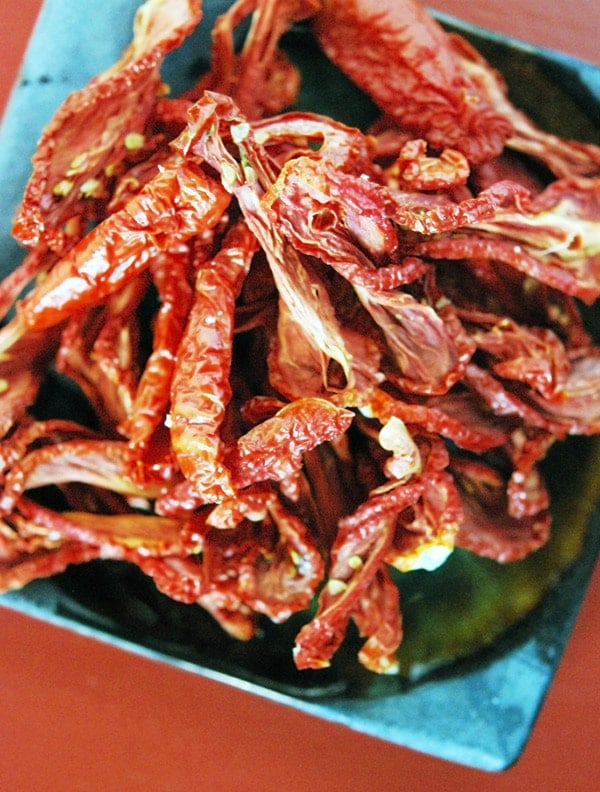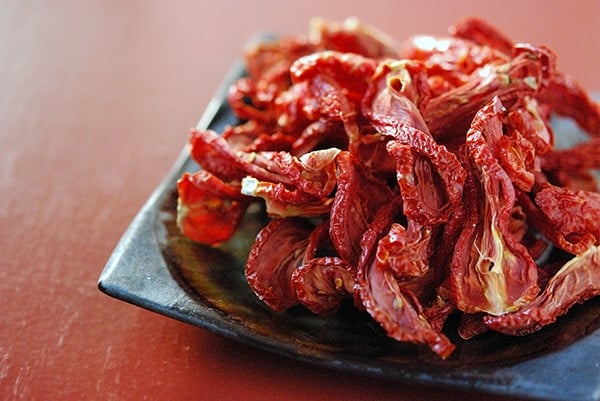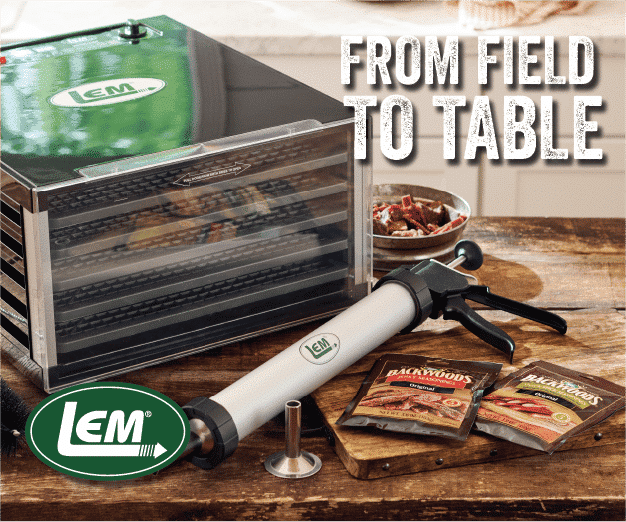As an Amazon Associate I earn from qualifying purchases.

“Oh my Gawd, it’s like an oven out here!” This is a not-uncommon refrain heard in Sacramento in summer. Well, if life gives you an oven, use it.
This is one of the few places in the country where I can consistently dry things without an oven: Sacramento typically sees summer days over 95 degrees and humidity levels below 60 percent, sometimes way below 60 percent. Perfect for drying.
Tomatoes, as anyone knows, have lots of water. Even the paste or processing tomatoes I use do. Forget about beefsteaks and most heirlooms, which, while tasty, have even more water in them than most maters. Getting 85 to 90 percent of that water out, which is what you need to properly preserve tomatoes (or anything, really) without cooking the tomato is tricky.
Most recipes ask you to put the slices into a warm oven, but even a warm oven will be close to 175°F. Yes, you can put the oven on its lowest setting, keep it ajar and use a fan to blow air into it, but that is an awful lot of work. Once you get past 130°F or so, you are cooking the tomato, and this irrevocably changes the flavor. You will also begin to lose vitamins.
A commercial dehydrator is another option, and it works great, especially if you live somewhere humid.
Here I have is the perfect natural dehydrator for drying tomatoes: My garage.
But Hank, these are not SUN dried tomatoes, then? No. No, they’re not. They’re better. Quick quiz: What does the sun do to colors? Time’s up. It bleaches them. Even the powerful color of a tomato often will be bleached in the time it takes to dry it. The much-darker garage prevents that color loss and leaves me with those pretty tomatoes you see above.
Getting this right isn’t as easy as skewering some tomatoes and hanging them haphazardly. I tried that, and was rewarded with a thriving colony of black mold. Big fail. Out $6 worth of tomatoes, I tried again. This time I added salt. Not good enough. I lost 80 percent of them to black mold.
This is the trade-off I am making for better tomatoes. I could put them in the sun — or inside my truck, where it is even hotter — but then I run the risk of losing color and flavor. No mold issue, but an inferior dried tomato. Doing it in the garage takes 2 to 4 days, enough time for mold to grow.

The answer? Red wine vinegar. I tried a third batch with a little vinegar, and lost only one tomato to mold. Here’s how I did it:
- I sliced paste tomatoes (big Romas) lengthwise into pieces about 1/4 inch wide.
- I sprinkled salt down on cookie sheets and poured some red wine vinegar into a bowl.
- Each tomato slice got a quick bath in the vinegar — only a second or two — and then was placed on the salted cookie sheet. When each sheet filled up, I sprinkled more salt on top.
- I skewered the tomato slices and hung them to dry in the garage. Why skewers? Because you then have as little contact with a hard surface as possible, and everything that touches a hard surface can trap moisture and promote mold growth. Do not let the tomatoes touch each other when hanging.
- Check them every day. You can take them down when the tomatoes are dry but leathery — this is how I like them — or when fully crispy.
The leathery tomatoes are perfect preserved underneath olive oil. They are a good antipasto all by themselves. The crispy ones can be tossed into soups or even powdered; powdered tomato makes a cool addition to a pasta dough.
Is there another method for drying tomatoes? You bet. In fact, I just learned a new one in, of all things, a book that focuses on grilled meat. I received a review copy of Peter Kaminsky and Francis Mallmann’s Seven Fires: Grilling the Argentine Way, and while perusing it I noticed an unusual method for drying tomatoes: Slicing them very thin and drying them on Silpats, which you bakers know as the ultimate non-stick mat.
This method requires neither vinegar nor salt, although I like a little salt tossed on for flavor. You do need a Silpat — otherwise good luck getting the dried slice off your cookie sheet — and a very sharp knife.
I sliced a few Romas about 1/16th of an inch thick and set them down on the Silpat and put that in the garage. Within 36 hours they were somewhere between the leathery and crispy stage. I tasted one: Chewy, oddly light yet meaty, with a blast of tomato flavor at the end. It was tomato ‘salami.’
I like this method so much I plan on putting up many jars of this ‘salami,’ preserved in olive oil like their regular dried cousins.
I can dry my own tomatoes with the best of them, and I make a good base tomato sauce that I put up for the winter. I make tomato paste the Sicilian way; they call it estrattu. I’m also messing around with some very old recipes I’ve found in a fascinating book called Preserving Food without Freezing or Canning. I’ll be back when I test them out. Be warned: Some are pretty freaky.





i had been looking for an alternative method of drying tomatoes and keep them. thanks for the useful post..
Kerry: Yes, that means you cannot CONSISTENTLY dry tomatoes in the sun without mold. You might be able to get away with it on unusually hot days, though. As for the dehydrator, I don’t use them, so I don’t know. Sorry.
Another question, Tomato Raisins how long would you put in dehydrater for and how can you tell they are perfectly dry. I imagine that if they weren’t completey dry they would rot??
Thanks
I live in Auckland New Zealand and we have high humidity, does this mean it would not work to sun dry tomoatoes?
Deanna: Good deal on the tomatoes, but, um, no. White mold is white mold, black mold is black mold. Neither is good, but black mold is, in general FAR worse for you than white mold. I ALWAYS throw things out that have black mold, but I have been known to eat things with white mold on them. Use your judgment.
I am using a homemade solar dehydrator made from plans in Mother Earth News, it has 2- 200 watt bulbs in the bottom for heat at night. i started a big batch of tomatoes yesterday and today (mid day) there are several tomatoes with a white ?mold on them. Is this what you call black mold? any ideas of what to do for this.
Thanks, Deanna
Thanks so much for the tips! Making some today in my tin shed! Its pretty hot in there! Im looking forward to seeing how it works out!
Jennifer: I put the leathery tomatoes in a Mason jar under olive oil in the pantry. Totally dry ones need no oil at all, and in fact I keep them in an open jar so they stay dry.
If you put them in the fridge the olive oil will solidify eventually, making it a pain to actually using the tomtoes.
I have never had my dired tomatoes last more than 6 months — because I’ve eaten them. They should last a year though.
My question is after they are dried, do I just put them in a jar in the fridge or how much oil and what kind of oil do I preserve them in. Is there a particular method to saving and how long can they be stored? Thanks
Hi Hank–I have my dehydrator loaded with my early ripening Stupices and grape-size Gold Nugget tomatoes right now. Most of them I just slice in half and lay skin-side down on the rack. I’m trying to dry some of the Gold Nuggets whole and see if I can get “tomato raisins.” During the recent heatwave here in Portland (temps in the 108 range for several days), I tried drying a batch on a basket outside, then in my car, covered with a sack cloth towel to prevent bleaching. Lost most to mold before I moved them to my dehydrator.
If you haven’t already, try making roast tomato sauce. Just did a micro-batch (1 pint) yesterday and my mouth is watering just thinking about that little jar in my fridge. Amazing flavor, without days of cooking–just six hours in the oven at 250F–which did not heat up my kitchen. The sauce is chunky, which I don’t particularly like, but the beauty is you can roast different colored tomatoes in separate pans, then layer them in a jar with herbs for a pretty presentation. For myself, I’ll just whiz up the roasted tomatoes, garlic, and shallot with my immersion blender for a smoother sauce. Here’s the recipe from Grist: https://www.grist.org/article/2009-07-23-summer-tomato-bounty/
I’ve been making my way through “Preserving Food…” for 2 years now. At first I was annoyed at the lack of specificity in many of the recipes, now I love it in that it reflects the real way we come up with and concoct new dishes..pinch here, dash there…Try the sauerkraut in glass jars. Dead easy and super tasty!
What about peaches and an abundance of fog? Our tree is going to ripen soon in this murkiest of summers. I guess I’ll have to purchase a dehydrator.
Jennifer: You bet a metal shed would work! Check on the tomatoes every 6-8 hours though, as it can get really hot in there…
I was just told about your Awesome blog by a friend on Twitter. I am know following you. My question is, Do you think a metal shed would work for drying out the tomatoes? I dont have a garage.
tomato salami–genius. I’ve got way too many tomatoes on my hands, I’ll be drying some soon!
I’ve had good luck (here in a dry climate) with drying romas on racks made of cheesecloth and lath stacked every ten inches or so in a medium sized cardboard box warmed by a 100 watt light bulb. The extra heat from the bulb was apparently enough to keep the mold at bay.
I have a friend whose mother grows Romas, and she owns a dehydrator. Dried homegrown tomatoes are worth their weight in gold. 🙂
always plenty of inspiration here Hank! I must admit to resort to my (electric) dehydrator. I do not have a garage (also have plenty of critters like… black bears), tried the green house but did not like the results. I do tomato confit too. That is fantastic, taste and texture-wise — looks similar to the “salami” tomatoes you talk about (except I use Italian type). I got the Terre Vivante book last winter… and I am having fun with it, although some of the stuff in there, i am not yet touching… For one, I don’t have a place which remains constantly under 50F which is what storage of some of the methods used in there require. But it is fascinating and mind-opening, for sure.
The other advantage to the use of the garage rather than the sun is the lack of UV rays that might do more than simply discolor the food.
In Southern France we dry hams in the shade at a fairly low temp.
Hum, saucisson, dried tomatoes and homemade bread…
Love the Silpat suggestion…now if my darn tomatoes would just get ripe I can actually try it out. And love Holly’s pix! Great work.